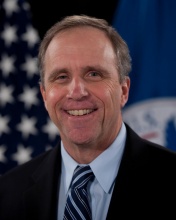

Rep. Scott Perry (R-Pa.) is holding a hearing Tuesday seeking answers from DHS on its plan to upgrade its financial systems.
Let me tell you a story, stop me if you’ve heard it before: A large Cabinet agency wants to modernize its financial management system by going to a shared service provider. After spending tens of millions of dollars over the last few years, they realize the effort will not work and terminates the initiative. Then, within a few months of ending that approach, they go out to industry seeking their help.
So how does this story end? Is there a punchline?
Rep. Scott Perry (R-Pa.), the chairman of the Homeland Security Subcommittee on Oversight and Management Efficiency, may get the answer on Sept. 26, when he holds a hearing looking at this exact story for the Homeland Security Department.
“DHS was told to go to a shared services provider and implement those systems and change through that, and even when the Government Accountability Office predicted it wasn’t going to go well, they continued, only for that prediction to come true,” Perry said in an interview with Federal News Radio. “After spending something like 60 percent more than originally estimated, DHS has zero to show for it, and no one is accountable.”
DHS decided to end its effort to move to the Interior Business Center earlier this year after failing to meet nearly all of its goals in consolidating and modernizing its financial systems. DHS soon issued a draft request for proposals and held an industry day detailing how it plans to move forward.
“We have a solution that works and gives us a solid place from which to build functionality and integration,” said Chip Fulghum, DHS’ deputy undersecretary for management, in an email to Federal News Radio. “We will use the lessons learned to date to mitigate future risks and deliver much-needed capability to our components, including solid, repeatable, controlled business processes that consistently produce accurate financial information and help us achieve our mission objectives.”
This means moving the Coast Guard and the Transportation Security Administration to the new systems and rescuing what they can from the Domestic Nuclear Detection Office’s accounting and procurement system transition to Interior. The efforts across all three agencies are known as the TRIO.
A DHS spokesman said delivering a standardized baseline financial system with increased functionality and integration for these three agencies remains a real goal.
“Our next steps to improve the department’s financial systems are to coordinate our transition and to obtain solutions to move the program forward,” the spokesman said. “We are coordinating our transition from DOI/IBC with the General Services Administration’s Unified Shared Services Management (USSM) and the Office of Management and Budget (OMB). DHS has matured and strengthened its acquisition management capabilities and operational requirements process to ensure the successful delivery of programs. The procurement is one part of that process and will incorporate best practices and lessons learned.”
This would be the fourth attempt over the last 15 years by DHS to consolidate and modernize its financial management system. It failed with the commercial solution twice and once with the federal provider.
This is why the draft request for proposals is leaving some in industry questioning whether DHS really has given its next move enough thought.
“To move forward with another RFP, especially under their EAGLE 2 vehicle, which will get them the same set of contractors that have failed previously, tells me they are moving too quickly and ought to take a step back and look at the lessons learned,” said Mike Hettinger, a former Hill staff member who led the oversight of financial systems, and is now a managing principal of Hettinger Strategy Group. “They should let Congress do oversight, and then proceed cautiously and figure out what best next step is.”
Hettinger said the draft RFP is a little confusing because it’s now clear how Interior factors into DHS’ future plans.
“What role will they play going forward? What hosted environment does DHS end up with after the move away from Interior? What role is there for the systems provider, because the companies on EAGLE 2 are mostly system integrators, so how will DHS get to the solution they need?” he said.
Another industry source, who is familiar with the DHS effort and requested anonymity because their company still does business with DHS, said there are several big issues that need to be addressed in the draft RFP.
“After all this time and money, I am struck with the notion that DHS will throw good money after bad to bolster up a procurement solution fraught with problems, which may or may not be able to be fixed,” the source said. “Someone would have to look at the inherent system design/functionality and then compare/contrast that with the mission needs of the user. The solution in place may actually not be what the DHS contracting practitioner needs to perform their mission adequately. They have no project-centric reports yet after three years. This is disturbing and translates into the fact that the solution involved does not collect, process or report on basic management oversight type of data.”
Industry expects this latest DHS effort to be worth at least $100 million.
Perry said the goal of the hearing is multi-fold. He wants DHS to convey and engender some confidence in their ability to get their financial house in order, detail their new strategy and publicly say who is accountable for this latest effort.
“We are upset with the inefficiency and waste and it’s our duty to deal with it,” Perry said. “We can’t afford for DHS to conduct business without productivity and accountability. It’s bad enough when you overspend and get what you want, but it’s wholly unacceptable when you overspend and have nothing to show for it.”
DHS’ challenges come as the Trump administration is emphasizing that agencies move to shared services as part of their reform efforts.
But few large agencies have successfully navigated the move to shared services.
The General Services Administration’s Unified Shared Services Management Office took a major step last week to change the federal approach. The USSM released a request for information for software-as-a-service.
“The purpose of this RFI is to understand the existing SaaS solutions for financial management and to gain industry feedback on best practices and potential hurdles to implementing SaaS for financial management,” the RFI states.
The RFI is seeking vendors who have current SaaS implementations that serve anywhere between 30,000 and 2.5 million users, are certified under the Federal Risk Authorization and Management Program for cloud security and have a mobile-friendly and user-responsive design.
Responses to the RFI are due Oct. 6.
“The way the new administration is looking at shared services will be different than the prior one did, but I don’t know if they have defined what they mean by shared services and I think they will over time. I don’t think it will be bricks-and-mortar hosted solutions,” Hettinger said. “I think they will look for more commercial involvement in the way of commercial solutions. I see a new vision for shared services USSM will be involved, but it will not be pushing a square peg into a round hole by pushing agencies to federal providers who don’t have the skillsets or resources to manage these transitions.”
At least for large agencies, that approach hasn’t worked out well.
Copyright © 2025 Federal News Network. All rights reserved. This website is not intended for users located within the European Economic Area.
Jason Miller is executive editor of Federal News Network and directs news coverage on the people, policy and programs of the federal government.
Follow @jmillerWFED



